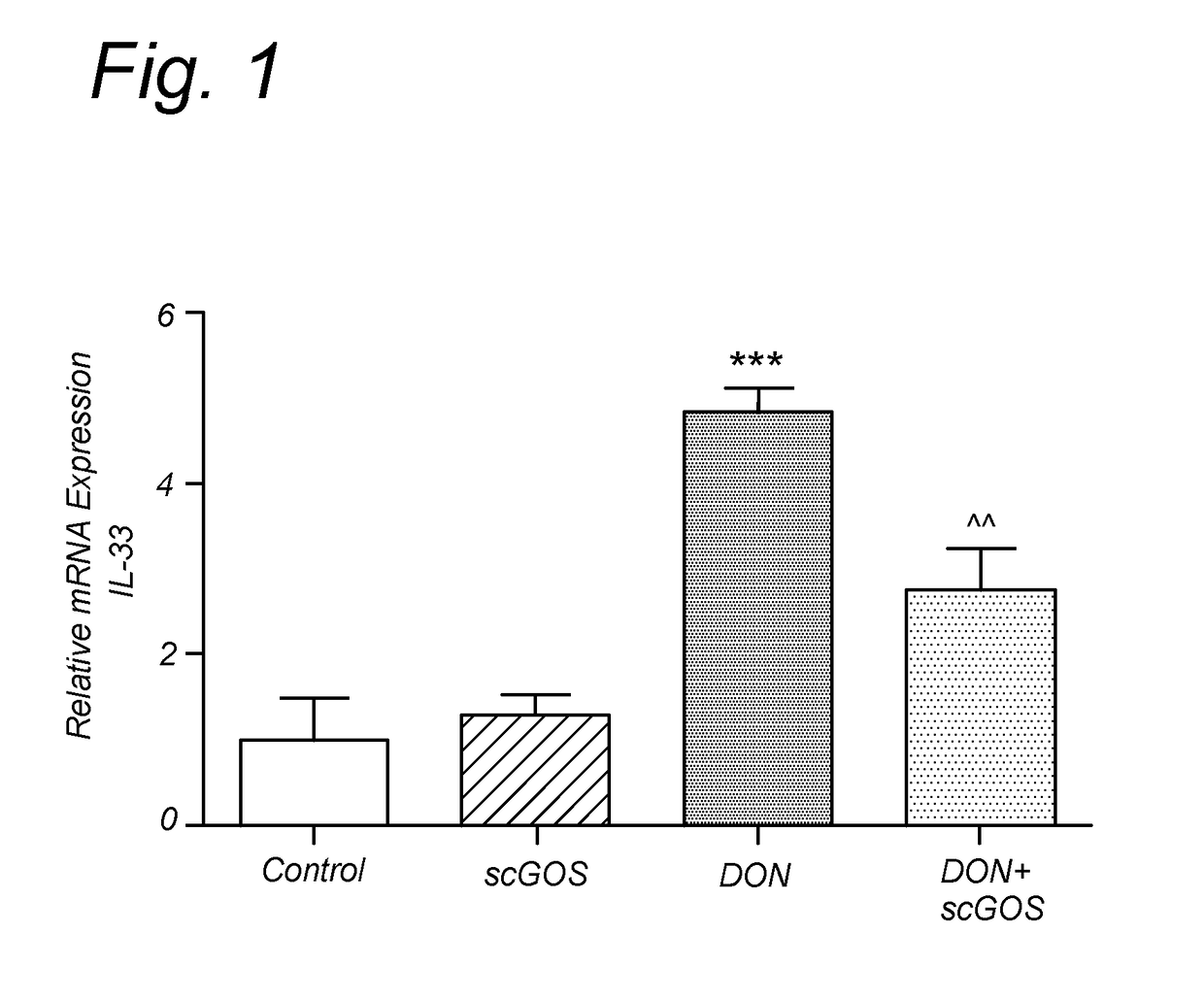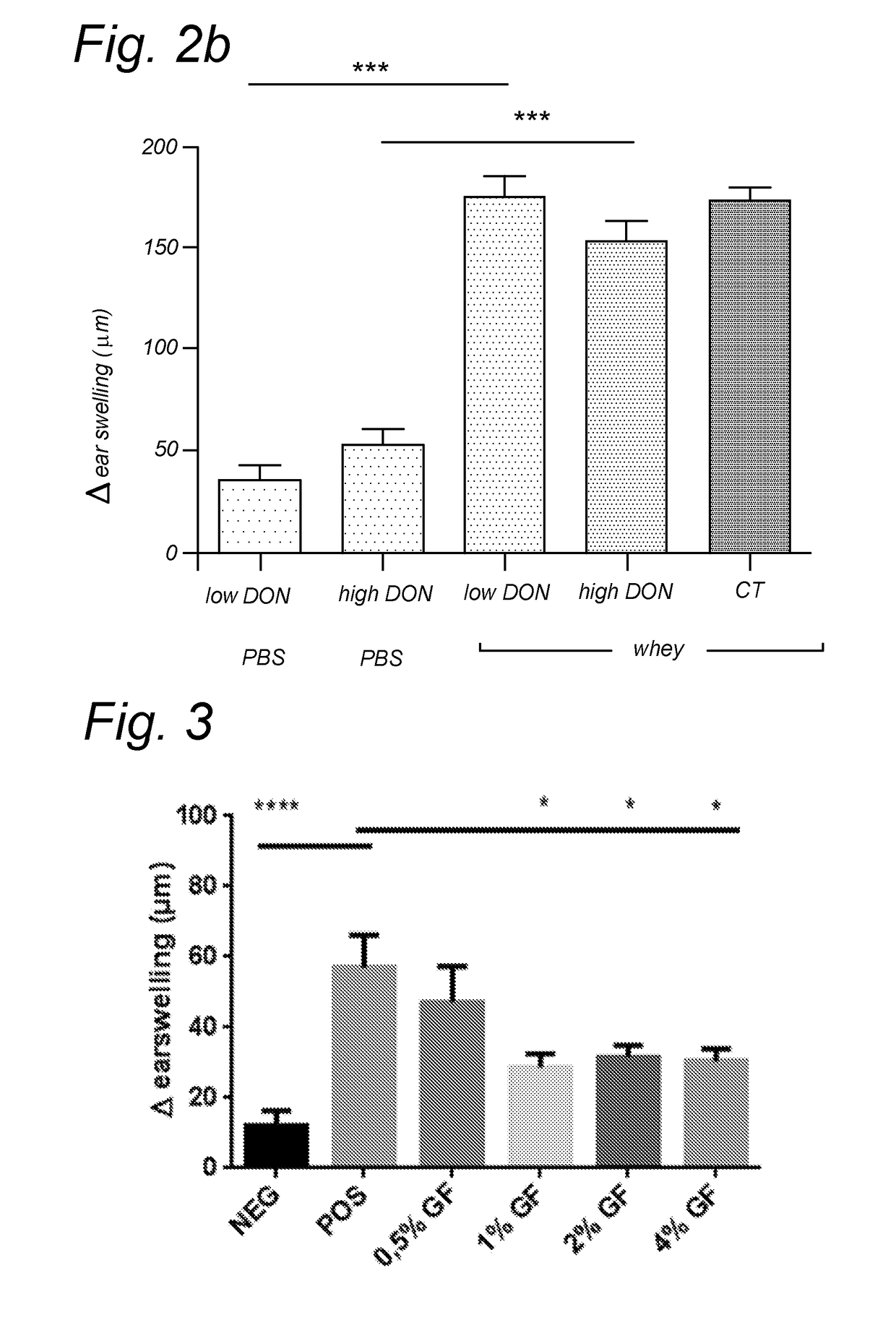Prevention or treatment of food allergy in infants and toddlers
a technology of food allergy and infants, applied in the field of non-digestible oligosaccharide composition, can solve the problems of increased risk of afflictions, infants and young children are often more susceptible than adults to various impairments, and mycotoxins may have dangerous effects on human and animal health, so as to reduce the risk of occurrence or prevention of food allergy, increase the risk of food allergy, and reduce the risk of occurrence or preventing food allergy
- Summary
- Abstract
- Description
- Claims
- Application Information
AI Technical Summary
Benefits of technology
Problems solved by technology
Method used
Image
Examples
example 1
[0114]Introduction
[0115]Mycotoxins are toxic natural secondary metabolites formed by fungi growing on agricultural commodities in the field or during storage. At global level, it is considered that 25% of the world crop production is contaminated by mycotoxins, which may be a risk factor for human health due to their toxic properties and their high stability to heat treatment. One of the most prevalent trichothecene mycotoxins is deoxynivalenol (DON). The aim of this example is to investigate the intestinal effect of DON on whey protein allergy through IL-33 mRNA expression, and the ability of galacto-oligosaccharides (GOS) to inhibit the DON-related effects.
[0116]Materials and Methods
[0117]Purified DON (D0156; Sigma-Aldrich, St Luis, Mo., USA) was diluted in absolute ethanol (99.9%) to prepare a 25 mM stock solution and was stored at −20° C. Serial dilutions of mycotoxins were prepared in DMEM medium.
[0118]Short-chain galacto-oligosaccharides (enzymatic elongation of lactose with g...
example 2
Allergic Sensitization in an In Vivo Mouse Study
[0137]Female C3H / HeOuJ mice were sensitized with a low or high dose deoxynivalenol (DON) with or without the whey protein (20 mg whey) five times weekly, as depicted in Table 2 below. The low dose consisted of 5 times 1 mg / kg body weight, whereas the high dose group received two times 10 mg / kg and three times 5 mg / kg DON. The average body weight of the mice throughout the experiment was 20 gram. At day 24, sera are collected to analyze the allergen-specific antibodies. At day 35, the antigen is intradermal injected (10 μg whey / 20 μl PBS / ear) in the ear pinnae and the corresponding ear swelling is measured as a read-out for the local activation of mast cells. The serum collected 30 minutes after the subsequent oral challenge (50 mg whey / 0.5 ml PBS / mouse) will give information about the mucosal mast cell response by measuring the mMCP-1. At day 36, the animals are euthanized, and blood and immunological relevant organs isolated.
TABLE 2Ov...
example 3
Composition According to the Invention
[0140]
(per 100 kgINGREDIENTSpowder)Demineralized whey [kg]19.4Vegetable oils [kg]19.1Skimmed milk [kg]16.3Maltodextrin [kg]13.5Dietary fibers [kg]:12.7galactooligosaccharides [kg]11.9fructopolysaccharides [kg]0.798Lactose [kg]12.6Whey protein concentrate [kg]3.58Tricalcium phosphate [kg]0.398Fish oil [kg]0.384Calcium carbonate [kg]0.356Tri potassium citrate [kg]0.257Tri sodium citrate [kg]0.140L-ascorbic acid [g]87.4Magnesium chloride [g]66.8Soy lecithin [g]59.5Taurine [g]34.1Choline chloride [g]30.1Vanillin [g]30.0Sodium L-ascorbate [g]29.9Ferrous sulphate [g]23.8Potassium chloride [g]23.0Zinc sulphate [g]13.9DL-alpha tocopheryl acetate [g]3.62Nicotinamide [g]2.87Folic acid [g]1.21Cholecalciferol [g]1.19Calcium D-pantothenate [g]1.08Cupric sulphate [g]1.07Retinyl palmitate [g]0.879DL-alpha tocopherol [g]0.836D-biotin [g]0.638Retinyl acetate [g]0.627Thiamin hydrochloride [g]0.402Cyanocobalamin [g]0.325Pyridoxine hydrochloride [g]0.245Riboflavin ...
PUM
| Property | Measurement | Unit |
|---|---|---|
| Time | aaaaa | aaaaa |
| Time | aaaaa | aaaaa |
Abstract
Description
Claims
Application Information
 Login to View More
Login to View More - R&D
- Intellectual Property
- Life Sciences
- Materials
- Tech Scout
- Unparalleled Data Quality
- Higher Quality Content
- 60% Fewer Hallucinations
Browse by: Latest US Patents, China's latest patents, Technical Efficacy Thesaurus, Application Domain, Technology Topic, Popular Technical Reports.
© 2025 PatSnap. All rights reserved.Legal|Privacy policy|Modern Slavery Act Transparency Statement|Sitemap|About US| Contact US: help@patsnap.com



